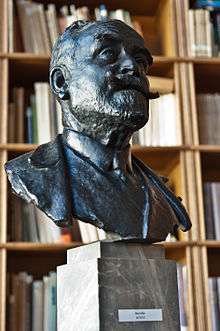Marcellin Boule
Pierre-Marcellin Boule (1 January 1861 – 4 July 1942), better known as merely Marcellin Boule, was a French palaeontologist, geologist, and anthropologist.[1]
Marcellin Boule | |
|---|---|
 | |
| Born | 1 January 1861 |
| Died | 4 July 1942 |
| Nationality | French |
| Known for | La Chapelle-aux-Saints 1 Neanderthal anatomy |
| Awards | Wollaston Medal (1933) |
| Scientific career | |
| Fields | Palaeontology, Geology, Anthropology |
Career
Boule was a professor at the Muséum National d’Histoire Naturelle, Paris (1902–36) and "for many years director of the Institut de Paléontologie Humaine, Paris."[1] He was an editor (1893–1940) of the journal L’Anthropologie (and contributed articles to it) and was the founder of two other scientific journals.[1]
Boule studied and published in 1910 the first analysis of a complete Neanderthal specimen.[2] The fossil discovered in La Chapelle-aux-Saints was an old man, and Boule characterized it as brutish, bent kneed and not a fully erect biped.[3] In an illustration Boule commissioned, the Neanderthal was characterized as a hairy gorilla-like figure with opposable toes, according to a skeleton which was already distorted with arthritis. As a result, Neanderthals were viewed in subsequent decades as being highly primitive creatures with no direct relation to anatomically modern humans. Later re-evaluations of the La Chapelle-aux-Saints skeleton have roundly discredited Boule's initial work on the specimen.[4]
He was one of the first to argue that eoliths were not manmade.[5]
Boule also expressed some scepticism about the Piltdown man discovery — later revealed to be a hoax. As early as 1915, Boule recognized that the jaw belonged to an ape rather than an ancient human.[6] However, the Piltdown forgery has been characterised as providing evidential support for Boule's "branching evolution" conclusions drawn from his Neanderthal research — research which is likewise said to have "prepar[ed] the international community for the appearance of a non-Neanderthal fossil such as Piltdown Man."[4]
Personal life and demise
Boule died at age 81 in the same town where he was born, Montsalvy, France.[1]
References and sources
- "Marcellin Boule". Encyclopædia Britannica. Retrieved February 10, 2020 – via britannica.com.
- Mooallem, Jon (January 11, 2017). "Neanderthals Were People, Too". The New York Times Magazine. Retrieved February 10, 2020.
- Boule, Marcellin (1920). Les hommes fossiles - Éléments de paléontologie humaine (in French). Paris: Masson et cie.
- Hammond, M. (1982). "The Expulsion of Neanderthals from Human Ancestry: Marcellin Boule and the Social Context of Scientific Research". Social Studies of Science. 12 (1): 1–36.
- Boule, Marcellin (1905). "L'origine des éolithes". L'Anthropologie (in French). XVI: 257–267.
- Boule, Marcellin (1915). "La paléontologie humaine en Angleterre". L'Anthropologie (in French). XXVI.
- Groenen, Marc (1994). Millon, J. (ed.). Pour une histoire de la préhistoire (in French). ISBN 2-905614-93-5.